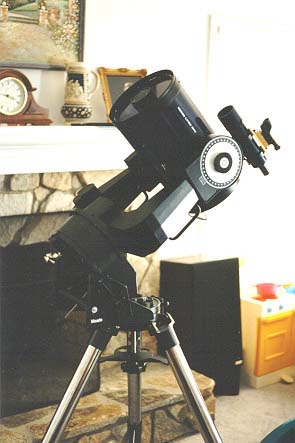
JeffPo's Telescopes & Equipment Page
Last update: 09/05/19
I received my first telescope at the tender age of 11 years old. It was a Sears 60mm refractor on an alt-azimuth mount. It came with an assortment of eyepieces, a moon filter, and a solar projection screen. It wasn't a great scope, but it really opened up the universe for me. I enjoyed viewing Jupiter, Saturn, and the Moon through it. It even performed okay on some of the brighter deepsky objects, like the Orion Nebula (M42). It was great for viewing sunspots with the solar projection screen.
Telescopes
Here you see my main "working" telescope. It's a Meade LX100 8" f/10 Schmidt-Cassegrain telescope that has been modified to function like a LX200. To learn more about this particular telescope and to see other telescopes I own and use, please click on the image.
Eyepieces
A telescope doesn't work without an eyepiece. And it doesn't work well without several eyepieces. Here you see my main "first view" eyepiece. It's a Televue 25mm Plossl. To see other eyepieces and related equipment that I own and use, please click on the image.
Filters
Sometimes an eyepiece or telescope needs a helping hand. That's where the various filters come into play. Here you see my moon filter. To learn more about this filter plus others that I use, please click on the image.
Finders
Let's face it, sometimes we need help in getting the telescope pointed at the right spot in the sky to see the object we are after. Here you see the 8x50 finder that I use on my LX100 Schmidt-Cassegrain telescope. To learn more about this finder plus others that I own and use, please click on the image.
Binoculars
Binoculars are a great tool for exploring the night sky. Here you see my Orion Mini Giant 9 x 63 binoculars. To learn more about these and others I have, please click on the image.
Star Charts
You need a map to get to an unknown location on the ground and you need a star chart to find your way among the celestial heavens. Here you see a popular device called a planisphere. To learn more about how it works and other charts that I use, please click on the image.
Flashlights
Though astronomers prefer the night to be pitch black, they still need light to see their charts and equipment. Given white light will ruin your dark adaptation, which is needed to see the really faint deepsky objects, astronomers use some type of red light. I've used a variety of lights over the years, from red plastic lens on regular flashlights to homemade LED lights (see my article on Building a LED Flashlight). But I've found the best results with commercial made versions.

Here you see my most used flashlight, the Rigel Starlite. They sell different varieties but I have found this one works the best for me. It has a rotary on/off switch that also adjusts the brightness. It has a lanyard for hanging it around your neck. It's rectangular so it won't roll around. And it has a switch for white LEDs in case you need white light. The have one where the rotary on/off dial is on top, and your can turn it one way for red light, and the other way for white light. I didn't like that one because I always seem to mix them up in the dark and would end up accidentally turning on the white light. This one works best because the switch for color selection is a separate switch. It runs off a 9v battery.